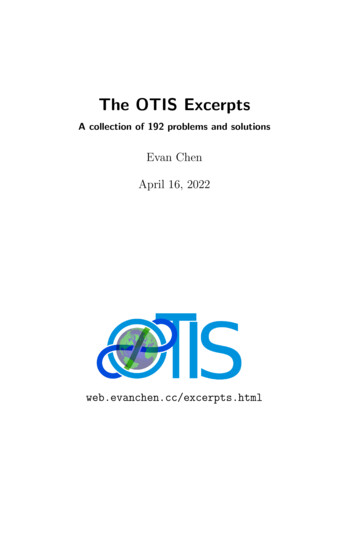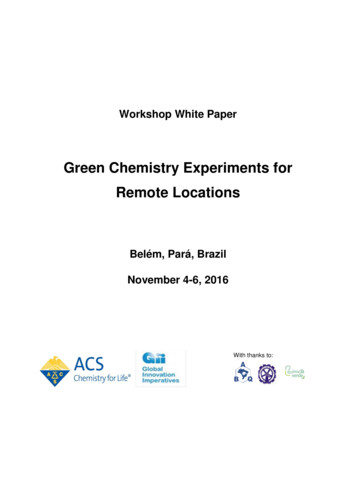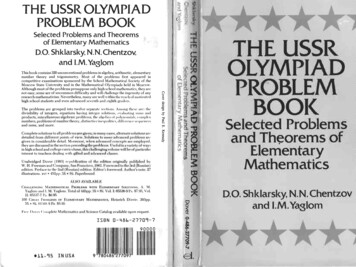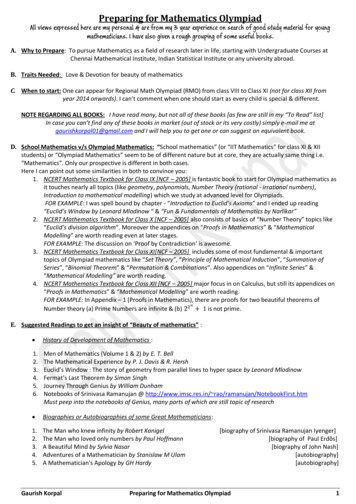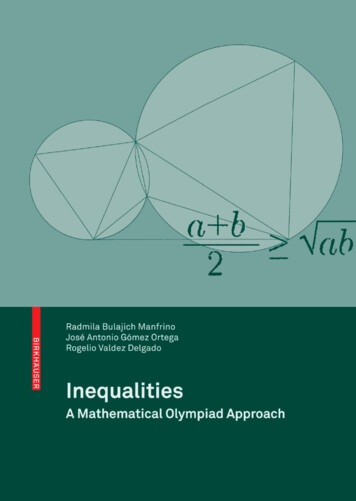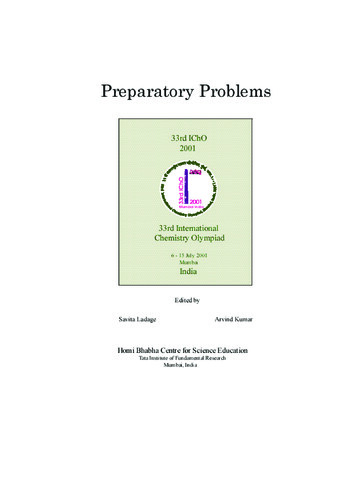
Transcription
33rd International Chemistry Olympiad Preparatory ProblemsPreparatory Problems33rd International Chemistry OlympiadEdited by Savita Ladage and Arvind KumarCopyright 2001 Homi Bhabha Centre for Science EducationPrinted in Mumbai, India.This publication is not for sale and may not be reproduced for lending, hire or sale. Teachersmay, however, reproduce material taken from the publication for use with their students forthe purpose of solving problems in chemistry.Homi Bhabha Centre for Science EducationTata Institute of Fundamental ResearchV.N.Purav Marg, MankhurdMumbai - 400088India.Mumbai, India, July 2001ii
33rd International Chemistry Olympiad Preparatory ProblemsContentsFrom the 33rd IChO SecretariativPrefacevDraft Syllabus for the International Chemistry Olympiadvii-xviTheoretical 5161718192021222324Watervan der Waals gasesRates and reaction mechanismsEnzyme catalysisSchrödinger equationAtomic and molecular orbitalsFissionRadioactive decayRedox reactionsSolubility of sparingly soluble saltsSpectrophotometryReactions in buffer mediumIdentification of an inorganic compoundIonic and metallic structuresCompounds of nitrogenStructure elucidation with stereochemistryOrganic spectroscopy and structure determinationPolymer synthesisOrganic synthesis involving regioselectionCarbon acidsAmino acids and enzymesCoenzyme chemistryProtein foldingProtein sequencingPractical Problems37-48Safety lem252627282930Determination of aspirin in the given sampleSynthesis of 1-phenyl-azo-2-naphthol C16H12ON2Estimation of calcium in a sample solutionEstimation of methyl ketone by back titrationEstimation of phenol in the given sampleDetermination of amount of Fe (III) present in the given sampleWorked Solutions to ProblemsMumbai, India, July 200149-111iii
33rd International Chemistry Olympiad Preparatory Problems33rd IChO National Scientific CommitteeProf. N. SathyamurthyIndian Institute of Technology, KanpurChairpersonProf. K. D. DeodharIndian Institute of Technology, MumbaiProf. S. DuraniIndian Institute of Technology, MumbaiProf. S. R. GadreUniversity of Pune, PuneProf. R. V. HosurTata Institute of Fundamental Research, MumbaiProf. Arvind KumarHomi Bhabha Centre for Science Education (TIFR), MumbaiDr. Savita LadageHomi Bhabha Centre for Science Education (TIFR), MumbaiProf. Uday MaitraIndian Institute of Science, BangaloreProf. R. N. MukherjeeIndian Institute of Technology, KanpurDr. R. P. PatelBhabha Atomic Research Centre, MumbaiDr. S. K. PatilBhabha Atomic Research Centre, Mumbai (formerly)Prof. N. S. PunekarIndian Institute of Technology, MumbaiProf. M. N. S. RaoIndian Institute of Technology, ChennaiDr. K. B. SainisBhabha Atomic Research Centre, MumbaiProf. S. D. SamantUniversity Dept of Chemical Technology, MumbaiProf. B. L. TembeIndian Institute of Technology, MumbaiProf. Y. D. VankarIndian Institute of Technology, KanpurSupporting Scientific StaffMs. Swapna NarvekarHomi Bhabha Centre for Science Education (TIFR), MumbaiMr. Rajesh KumarHomi Bhabha Centre for Science Education (TIFR), MumbaiMumbai, India, July 2001iv
33rd International Chemistry Olympiad Preparatory ProblemsSYLLABUS OF THE INTERNATIONAL CHEMISTRY OLYMPIADLevel 1:These topics are included in the overwhelming majority of secondaryschool chemistry programs and need not be mentioned in thepreparatory problemsLevel 2:These topics are included in a substantial number of secondary schoolprograms and maybe used without exemplification in the preparatoryproblems.Level 3:These topics are not included in the majority of secondary schoolprograms and can only be used in the competition if examples aregiven in the preparatory problems1 INORGANIC CHEMISTRY1.4 Structures1.11.4.1 simple molecular structures1.4.2 simple molecular structures withcentral atom exceeding octet rule1.4.3 ionic crystal structures1.4.4 metal structures1.4.5 stereochemistryElectronic configuration of atomsand ions1.1.11.1.21.1.31.1.41.1.5main groupstransition metalslanthanide and actinide metalsPauli exclusion principleHund's rule1.2Trends in the periodic table(main vityelectron affinityfirst ionisation energyatomic sizeionic sizehighest oxidation number1.312311122121Trends in physical properties(main groups)1.3.1 melting point1.3.2 boiling point1.3.3 metal character1.3.4 magnetic properties1.3.5 thermal properties1.3.6 law of Dulong and Petit1.3.7 electrical conductivityMumbai, India, July 20011112313233331.5 Nomenclature1.5.11.5.21.5.31.5.41.5.5oxidation numbermain group compoundstransition metal compoundssimple metal complexesmulticenter metal complexes111231.6 Chemical g equationsstoichiometric calculationsmass and volume relationsempirical formulaAvogadro's numberconcentration calculations1111111.7 Isotopes1.7.11.7.21.7.3counting of nucleonsradioactive decaynuclear reactions (alpha, beta,gamma, neutrino)112v
33rd International Chemistry Olympiad Preparatory Problems1.8 Natural cycles1.8.1 nitrogen1.8.2 oxygen1.8.3 carbon2221.9 s-Block1.9.1 Products of reactions of group Iand II metals1.9.1.1 with water, basicity of theproducts1.9.1.2 with halogens1.9.1.3 with oxygen1.9.2 heavier s-block elements aremore reactive1.9.3 lithium combines with H2 and N2forming LiH and Li3N1.11 d-Block112121.10 p-Block1.10.1 stoichiometry of simplestnon-metal hydrides11.10.2 properties of metal hydrides31.10.3 acid-base properties of CH4, NH3,H2O, H2S, and hydrogenhalides HX11.10.4 NO reacts with O2 to form NO211.10.5 equilibrium between NO2 and1N2O41.10.6 products of reaction of NO2 withwater11.10.7 HNO2 and its salts are reductants 11.10.8 HNO3 and its salts are oxidants131.10.9 N2H4 is a liquid and reductant1.10.10 there exist acids like H2N2O2,3HN31.10.11 reactions of HNO3 with differentmetals and reductants31.10.12 reaction of Na2S2O3 with iodine 21.10.13 other thioacids, polyacids,peroxoacids31.10.14 B(III), Al(III), Si(IV), P(V),S(IV), S(VI), O(-II), F(-I), Cl(-I),Cl(I), Cl(III), Cl(V), Cl(VII)are normal oxidation states of2nd and 3rd row elementsin compounds withhalogens and in oxoanions11.10.15 compounds of non-metals withother oxidation states31.10.16 the preferred oxidation states2are Sn(II), Pb(II) and Bi(III)1.10.17 products of reactions of non-metalvioxides with water andstoichiometry of resulting acids11.10.18 reactions of halogens with water 21.10.19 reactivity and oxidising power ofhalogens decrease from F2 to I2 11.10.20 differences of chemistry betweenrow 4 and row 3 elements31.11.1 common oxidation states of thecommon d-block metals are Cr(III),Cr(VI), Mn(II), Mn(IV), Mn(VII),Fe(II), Fe(III), Co(II), Ni(II), Cu(I),Cu(II), Ag(I), Zn(II), Hg(I), andHg(II)11.11.2 colours of the listed commonions in aqueous solutions21.11.3 other oxidation states and chemistryof other d-block elements31.11.4 Cr, Mn, Fe, Co, Ni, Zn dissolve indilute HCl; Cu, Ag, Hg do notdissolve11.11.5 products of dissolution are (2 )cations21.11.6 passivaion of Cr, Fe (and also Al) 2l.11.7 Cr(OH)3 and Zn(OH)2 are amphoteric,other common hydroxides are not 11.11.8 MnO4-, CrO42-, Cr2O72- arestrong oxidants11.11.9 products of reduction of MnO4depending on pH21.11.10 polyanions other than Cr2O7231.12 Other inorganic problems1.12.1 industrial production of H2SO4,NH3, Na2CO3, Na, Cl2, NaOH,1.12.2 chemistry of lanthanides andactinides1.12.3 chemistry of noble gases1332. PHYSICAL CHEMISTRY2.1 Chemical equilibria2.1.1 dynamical model of chemicalequilibrium12.1.2 chemical equilibria expressed in termsof relative concentrations12.1.3 chemical equilibria expressed interms of partial pressures22.1.4 the relationship between equilibriumconstants for ideal gases expressedin different ways (concentration,Mumbai, India, July 2001
33rd International Chemistry Olympiad Preparatory Problemspressure, mole fraction)2.1.5 relation of equilibrium constantand standard Gibbs energy332.2 Ionic equilibria2.2.1 Arrhenius theory of acids andbases12.2.2 Broensted-Lowry theory, conjugatedacids and bases12.2.3 definition of pH12.2.4 ionic product of water12.2.5 relation between Ka and Kb forconjugated acids and bases12.2.6 hydrolysis of salts12.2.7 solubility product - definition12.2.8 calculation of solubility (in water)from solubility product12.2.9 calculation of pH for weak acid fromKa12.2.10 calculation of pH for 10-7 mol dm-3HCl solution22.2.11 calculation of pH for multiproticacids22.2.12 calculation of pH for weak acidmixtures32.2.13 definition of activity coefficient22.2.14 definition of ionic strength32.2.15 Debye-Hückel formula32.3 Electrode ive force (definition)first kind electrodesstandard electrode potentialNernst equationsecond kind electrodesrelation between G andelectromotive force1112232.4.10 Arrhenius equation, activationenergy (definition)2.4.11 calculation of rate constantfor 1st order reaction2.4.12 calculation of rate constant forsecond, third order reaction2.4.13 calculation of activation energyfrom experimental data2.4.14 basic concepts of collision theory2.4.15 basic concepts of transition statetheory2.4.16 opposing, parallel and consecutivereactions22333332.5 Thermodynamics (First law)2.5.1 system and its surroundings22.5.2 energy, heat and work22.5.3 relation between enthalpy andenergy22.5.4 heat capacity – definition22.5.5 difference between Cp and Cv(ideal gas only)22.5.6 Hess law22.5.7 Born-Haber cycle for ioniccompounds32.5.8 lattice energies – approximatecalculations (e.g. Kapustinskiequation)32.5.9 use of standard formationenthalpies22.5.10 heats of solution and solvation22.5.11 bond energies - definition and uses 22.6 Thermodynamics (Second law)2.6.12.6.22.6.32.6.42.6.5entropy, definition (q/T)entropy and disorderrelation S k ln Wrelation G H - T S G and directionality of changes223222.4 Kinetics of homogeneous reactions2.7 Phase .9factors influencing reaction rate1rate equation1rate constant1order of reactions21st order reactions: time dependenceof concentration21st order reactions: half-life21st order reactions: relation betweenhalf-life and rate constant2rate-determining step2molecularity2Mumbai, India, July 20012.7.12.7.22.7.32.7.4ideal gas lawvan der Waals gas lawdefinition of partial pressuretemperature dependence of thevapour pressure of liquid2.7.5 Clausius-Clapeyron equation2.7.5 reading phase diagrams:triple point2.7.6 phase diagrams:critical temperature1312333vii
33rd International Chemistry Olympiad Preparatory Problems2.7.8 liquid-vapour system (diagram)32.7.9 liquid-vapour: ideal and non-idealsystems32.7.10 liquid-vapour: use in fractionaldistillation32.7.11 Henry's law22.7.12 Raoult's law22.7.13 deviations from Raoult's law32.7.14 boiling point elevation law22.7.15 freezing point depression,determination of molar mass22.7.16 osmotic pressure22.7.17 partition coefficient32.7.18 solvent extraction32.7.19 basic principles of chromatography23.5 Arenes and heterocycles3. ORGANIC CHEMISTRY3.6 Halogen compounds3.1 Alkanes3.6.1 hydrolytic reactions3.6.2 exchange of halogens3.6.3 reactivity (primary vs secondary vstertiary)3.6.4 ionic mechanism of substitution3.6.5 side products (elimination)3.6.6 reactivity (aliphatic vs aromatic)3.6.7 Wurtz (RX Na) reaction3.6.8 halogen derivatives and pollution3.1.1 isomers of butane3.1.2 naming (IUPAC)3.1.3 trends in physical properties3.1.4 substitution (e.g. with Cl2)3.1.4.1 products3.1.4.2 free radicals3.1.4.3 initiation/termination of thechain reaction111123.5.13.5.23.5.33.5.43.5.53.5.6formula of benzenedelocalization of electronsstabilization by resonanceHückel (4n 2) rulearomaticity of heterocyclesnomenclature of heterocycles(IUPAC)3.5.7 polycyclic aromatic compounds3.5.7 effect of first substituent onreactivity3.5.9 effect of first substituent ondirection of substitution3.5.10 explanation of substituent effects11133332232322223323.7 Alcohols and phenols3.2 Cycloalkanes3.2.1 names3.2.2 strain in small rings3.2.3 chair/boat conformation1223.3 Alkenes3.3.1 planarity13.3.2 E/Z (cis-trans) isomerism13.3.3 Addition of Br2 and HBr3.3.3.1 products13.3.3.2 Markovnikoff's rule23.3.3.3 carbonium ions in additionreaction33.3.3.4 relative stability of carbonium ions 33.3.3.5 1,4-addition to alkadiene33.4 Alkynes3.4.1 linear geometry13.4.2 acidity23.4.3 differences in chemical propertiesbetween alkenes and alkynes3viii3.7.1 hydrogen bonding - alcohols vsethers3.7.2 acidity of alcohols vs phenols3.7.3 dehydration to alkenes3.7.4 dehydration to ethers3.7.5 esters with inorganic acids3.7.6 iodoform reaction3.7.7 reactions of primary/secondary/tertiary: Lucas reagent3.7.8 formula of glycerin121222213.8 Carbonyl compounds3.8.1 nomenclature3.8.2 keto/enol tautomerism123.8.3 Preparation of carbonyl compounds3.8.3.1 oxidation of alcohols13.8.3.2 from carbon monoxide33.8.4 Reaction of carbonyl compounds3.8.4.1 oxidation of aldehydes13.8.4.2 reduction with Zn metal23.8.4.3 addition of HCN223.8.4.4 addition of NaHSO3Mumbai, India, July 2001
33rd International Chemistry Olympiad Preparatory Problems3.8.4.5 addition of NH2OH3.8.4.6 aldol condensation3.8.4.7 preparation of acetates3.8.4.8 Cannizzaro (PhCH2OHdisproportionation)3.8.4.9 Grignard reaction3.8.4.10 Fehling (Cu2O) and Tollens(Ag rboxylic acids3.11.113.10.1 inductive effect and strength3.10.2 equivalence of oxygen atoms inanions3.10.3 Preparation and reactions ofcarboxylic acids3.10.3.1 preparation from esters3.10.3.2 preparation from nitriles3.10.3.3 products of reaction withalcohols (esters)3.10.3.4 mechanism of esterification3.10.3.5 isotopes in mechanismelucidation3.10.3.6 nomenclature of acid halides3.10.3.7 preparation of acid chlorides3.10.3.8 preparation of amides fromacid chlorides3.10.3.9 preparation of nitriles fromacid chlorides3.10.3.10 properties and preparation ofanhydrides3.10.3.11 oxalic acid, name and formula3.10.3.12 multifunctional acids(e.g. hydroxyacids, ketoacids)3.10.3.13 polycarboxylic acids3.10.3.14 optical activity (e.g. lactic acid3.10.3.15 R/S nomenclature3.10.3.16 plant and animal fats,differences23.11.12232333333.12 Some large drophobic groupsmicelle structurepreparation of soapsproducts of polymerization of:3.12.4 styrene3.12.5 ethene3.12.6 polyamides3.12.7 phenol aldehydes3.12.8 polyuretanes3.12.9 polymers cross linking3.12.10 chain mechanism of polymerformation3.12.11 rubber composition23121333323214. BIOCHEMISTRY222323.11 Nitrogen compounds3.11.1 basicity of amines13.11.2 comparing aliphatic vs aromatic 23.11.3 names: primary, secondary,tertiary, quaternary amines23.11.4 identificationof primary/sec./tert./quaternary amines in laboratory 33.11.5 Preparation of amines3.11.5.1 from halogen compounds23.11.5.2 from nitro compounds (e.g. PhNH2from PhNO2)33.11.5.3 from amides (Hoffmann)3Mumbai, India, July 2001mechanism of Hoffmannrearrangement in acidic/basicmediumbasicity amines vs amidesdiazotation products ofaliphatic aminesdiazotation products ofaromatic aminesdyes:colour vs structure(chromophore groups)nitrocompounds: ments4.1Amino acids and peptides4.1.1 ionic structure of aminoacids4.1.2 isoelectric point4.1.3 20 aminoacids (classification ingroups)4.1.4 20 aminoacids (names andstructures)4.1.5 ninhydrin reaction (includingequation)4.1.6 separation by chromatography4.1.7 separation by electrophoresis4.1.8 peptide linkage122333314.2 Proteins4.2.14.2.24.2.34.2.4primary structure of proteins-S-S- bridgessequence analysissecondary structures1333ix
33rd International Chemistry Olympiad Preparatory 24.2.134.2.144.2.15details of alpha-helix structuretertiary structuredenaturation reaction by changeof pH, temperature, metals,ethanolquaternary structureseparation of proteins (moleculesize and solubility)metabolism of proteins (general)proteolysistransaminationfour pathways of catabolism ofamino acidsdecarboxylation of amino acidsurea cycle (only results)334.3.34.3.44.3.54.3.64.3.74.3.8IUPAC names from C4 to C18trivial names of most important(ca. 5) fatty acidsgeneral metabolism of fatsbeta-oxidation of fatty acids(formulas and ATP balance)fatty acids and fats anabolismphosphoglyceridesmembranesactive transport233333333222333334.6.1 formation of CO2 in the cycle(no details)4.6.2 intermediate compounds in thecycle4.6.3 formation of water and ATP(no details)4.6.4 FMN and cytochromes4.6.5 calculation of ATP amount for1 mole of .94.7.94.4.14.4.24.7.114.7.12general properties, active centres 2nomenclature, kinetics, coenzymes,function of ATP, etc.34.7.134.7.144.7.154.7.164.5 Saccharidesx223322233323333334.7 Nucleic acids and protein synthesis4.4 Enzymesglucose and fructose:4.5.1 - chain formulas4.5.2 - Fischer projections4.5.3 - Haworth formulas4.5.4 osazones4.5.5 maltose as reducing sugar4.5.6 difference between starch andcellulose4.5.7 difference between alpha- andbeta-D glucose4.5.8 metabolism from starch to acetyl-CoA4.5.9 pathway to lactic acid or toethanol; catabolism of glucose4.5.10 ATP balance for the abovepathways4.5.11 photosynthesis (products only)4.5.12 light and dark reaction34.6 Krebs cycle and respiration chain4.3 Fatty acids and fats4.3.14.3.24.5.13 detailed Calvin cyclepyrimidine, purine2nucleosides and nucleotides3formulas of all pyrimidine andpurine bases3difference between ribose and2-deoxyribose3base combination CG and AT3base combination CG and AT –(hydrogen bonding structure)3difference between DNA and RNA 3difference between mRNA andtRNA3hydrolysis of nucleic acids3semiconservative replication ofDNA3DNA-ligase3RNA synthesis (transcription)without details3reverse transcriptase3use of genetic code3start and stop codons3translation steps34.8 Other biochemical rmones, regulation3hormones, feedback3insulin, glucagon, adrenaline3mineral metabolism (no details)3ions in blood3buffers in blood3haemoglobin; function and skeleton 3haemoglobin; diagram of oxygenabsorption34.8.9 steps in clotting the blood34.8.10 antigens and antibodies34.8.11 blood groups34.8.12 acetyl choline, structure andfunctions3Mumbai, India, July 2001
33rd International Chemistry Olympiad Preparatory ProblemsOTHER PROBLEMS8. Instrumental methods of determiningstructure5. Analytical chemistry8.1 UV-VIS spectroscopy5.15.25.35.45.55.65.75.85.9choice of indicators for acidimetry 1titration curve; pH (strong and weakacid)2EMF (redox titration)2calculation of pH of simplebuffer solution2identification of Ag , Ba2 , Cl-, SO42- 1identification of Al3 , NO2-, NO3-, Bi3 2identification of VO3-, ClO3-, Ti4 3use of flame tests for identificationof K, Ca a Sr1Beer-Lambert law28.1.1 identification of aromatic compound 38.1.2 identification of chromophore38.2 Mass spectrarecognition of:8.2.1- molecular ion8.2.2- fragments with a help of a table8.2.3 typical isotope distribution3338.3 Infrared spectra6.6.16.26.36.46.56.66.7Complexeswriting down complexation reactions1definition of coordination number 1prediction of coordination number ofcomplex ions and molecules3complex formation constants(definition)2Eg and T2g terms: high and low spinoctahedral complexes3calculation of solubility of AgCl in NH3(from Ks and constants β)3cis and trans forms37. Theoretical chemistry7.1 energy levels of hydrogen atom(formula)7.2 square of the wave functionand probability7.3 understanding the simplestSchrödinger equation7.4 n, l, m quantum numbers7.5 shape of p-orbitals7.6 d orbital stereoconfiguration7.7 molecular orbital diagram:H2 molecule7.8 molecular orbital diagram:N2 and O2 molecules7.9 bond orders in O2, O2 , O27.9 unpaired electrons andparamagnetism7.10 Hückel theory for aromaticcompounds7.12 Lewis acids and bases7.13 hard and soft Lewis acidsMumbai, India, July 20018.3.1 interpretation using a table ofgroup frequencies8.3.2 recognition of hydrogen bonds8.3.3 Raman spectroscopy3338.4 NMR8.4.1 interpretation of simplespectrum (like ethanol)8.4.2 spin-spin coupling8.4.3 coupling constants8.4.4 identification of o- and psubstituted benzene8.4.5 13C- NMR333338.5 X-rays2332238.5.18.5.28.5.38.5.4Bragg lawelectron density diagramcoordination numberunit cell333333structures:8.5.5- of NaCl8.5.6- of CsCl8.5.7- close-packed (2 types)8.5.8 determining of the Avogadroconstant from X-ray data28.6 Polarimetry3238.6.1 calculation of specific rotation angle 323333xi
33rd International Chemistry Olympiad Preparatory ProblemsSyllabus for the Experimental Part of the IChO CompetitionLevel 1Level 2Level 1.151.161.171.181.191.201.211.221.23is assigned to the basic experimental activities which are supposed tobe mastered by competitors very well.is assigned to the activities which are parts of school experimentalexercises in developed countries and the authors of IChO tasks mayincorporate them into the tasks without being bounded to mention it inadvance.is assigned to such activities which are not in the chemistry syllabus inthe majority of participating countries and the authors are obliged tomention them in the set of preparatory tasks.Synthesis of inorganic andorganic compoundsheating with burners and hotplates 1heating of liquids1handling the work with inflammablesubstances and materials1measuring of masses(analytical balance)1measuring of volumes of liquids(measuring cylinder, pipette, burette)1preparation of solutionsfrom a solid compound and solvent 1mixing and dilution of solutions 1mixing and stirring of liquids1using mixer and magnetic stirrer2using a dropping funnel1syntheses in flat bottom vessels –general principles1syntheses in round bottom vessels –general principles1syntheses in a closed apparatus –general principles1using microscale equipment forsynthesis3apparatus for heating ofreaction mixture under reflux2apparatus for distillation of liquids atnormal pressure 2apparatus for distillation of liquids atreduced pressure3apparatus for steam distillation3filtration through flat paper filter1filtration through a folded paper filter1handling a water vacuum pump1filtration through a Büchner funnel 1suction through a glass filter11.24 washing of precipitates bydecantation11.25 washing of precipitates on a filter 21.26 drying of precipitates on a filterwith appropriate solvents21.27 recrystallization of substances fromaqueous solution11.28 recrystallization of substances froma known organic solvent21.29 practical choice of an appropriatesolvent for recrystallization ofa substance31.30 drying of substances in a dryingbox21.31 drying of substances in adesiccator21.32 connecting and using of a gaswashing bottle21.33 extraction with an inmisciblesolvent12.Identification of inorganic andorganic compounds- generalprinciples2.12.2test-tube reactions1technique of reactions performed in adot dish and on a filter paper1group reactions of some cations andanions specified by the organizer 2selective reactions of some cationsand anions specified by theorganizer2specific reactions of some cations andanions specified by the organizer 3identification of elements by flamecoloration (using a platinum wire/MgO2.32.42.52.6Mumbai, India, July 2001xii
33rd International Chemistry Olympiad Preparatory Problems3.11 other types of determinations on basisrod, Co-glass)2of redox reactions32.7 using a hand spectroscope/3.13 complexometric determinations3Bunsen spectroscope32.8 melting point determination with Kofler 3.14 color transitions of solutionsat complexometric determinations 3or similar type of apparatus32.9 qualitative evidence of basic functional 3.15 volumetric determinationson basis of precipitation reactions 3groups of organic substances specifiedby the organizer23.16 thermometric titration32.10 exploitation of some specific reactionsfor identification of organic compounds 4. Special measurements and(specified by the organizer)3procedures3. Determination of some inorganic andorganic compounds- general principles3.1quantitative determinations usingprecipitation reactions3.2 igniting of a precipitate in a crucible3.3 quantitative volumetricdeterminations3.4 rules at titrating3.5 use of a pipetting ball3.6 preparation of a standard solution3.7 alkalimetric and acidimetricdeterminations3.8color transitions of indicators at aalkalimetric and acidimetricdeterminations3.9direct and indirect determinations(back titration)3.10 manganometric determinations3.11 iodometric determinationsMumbai, India, July 2001214.1 measuring with a pH-meter4.2chromatography on thin layers4.3 column chromatography4.4 separation on ion exchanger4.5. measuring of UV-VIS absorbanceswith a spectral photometer4.6. performing of n of results5.1Estimation of experimental errors(significant figures, plots scales)16. If the organizer wants to apply atechnique which is notmentioned in the abovesyllabus, this technique is set tolevel 3 automatically.xiii
33rd International Chemistry Olympiad Preparatory ProblemsValues of Some Fundamental ConstantsAvogadro numberNA 6.022 x 1023 mol-1Faraday constantF 96485 C mol-1Gas constantR 8.314 J. K-1. mol-1Planck’s constanth 6.626 x 10-34 J.sMass of electronme 9.110 x 10-31 kgNotes:1.The symbol [X] denotes concentration of X. It may carry the unit mol L-1 or, insome places, may denote concentration relative to the standard concentrationof 1M, in which case it is dimensionless. The particular usage should beobvious from the context. All equilibrium constants are dimensionless.2.The knowledge of mathematics required for the contest problems of the 33rdIChO will be no more than that indicated by the problems in this collection.Mumbai, India, July 2001xiv
33rd International Chemistry Olympiad Preparatory ProblemsTheoretical ProblemsProblem 1 WaterWater, the commonest substance around us, is an excellent system to understandmany concepts of thermodynamics. It exists in three different phases: solid (ice),liquid and vapour. [At high pressures, different solid phases of ice exist, but we donot consider them here.] The phase diagram for water, which gives the pressureversus temperature curves for its different phases in equilibrium, is shown below:Phase diagram223Pressure / barA.SolidLiquid1.016.11 x 10 30Vapour0.01100374Temperature / CPhase diagram of water (not to scale)a.At what temperature and pressure do all the three phases of water coexist inequilibrium?b.What is the effect of decrease of pressure on boiling point of water andmelting point of ice, as seen from the phase diagram?c.The liquid-vapour coexistence curve ends at the point Pc 223 bar and Tc 374oC. What is the significance of this point?d.What is the phase of water at T 300 K, P 12.0 bar; T 270 K, P 1.00bar?Mumbai, India, July 20011
33rd International Chemistry Olympiad Preparatory Problemse.Below what value of pressure will ice, when heated isobarically, sublimate tovapour?f.At a certain temperature and pressure on the liquid-vapour co-existence line,the molar volumes of water in the two phases areVl 3.15 x 10 5 m 3V v 15.8 10 5 m3For 1.00 mole of water in a 0.100 litre vessel at this temperature andpressure, determine the volume fractions in liquid and vapour phases.B.Clausius – Clapeyron equationa.Explain your answer to part A. b above on the basis of the Clapeyronequation.b.Autoclaves used for medical sterilisation need to have a temperature of 120 Cof boiling water to kill most bacteria. Estimate the pressure required for thepurpose. The molar enthalpy change of vaporisation of water is 40.66 kJ mol 1at the normal boiling point. Indicate the assumptions made in your estimate.c.The molar enthalpy change of fusion at normal freezing point (273.15 K) is6008 J mol 1. Estimate the pressure at which water and ice are in equilibriumat – 0.200 C. Density of ice 917 kg m 3 and density of water 1000 kg m 3.Indicate the assumptions made in your estimate.C.Irreversible condensationa.Consider 28.5 g of supercooled (liquid) water at 12.0 C and 1.00 bar. Doesthis state lie on the P - T plane of the phase diagram?b.This metastable state suddenly freezes to ice at the same temperature andpressure. Treat the metastable state as an equilibrium state and calculate theheat released in the process. Molar heat capacities, assumed constant, are :C p(ice) 76.1 JK 1mol 1C p (liquid water) 37.15 JK 1mol 1 H(fusion) 333.5 J g 12Mumbai, India, July 2001
33rd International Chemistry Olympiad Preparatory Problemsc.Determine the total entropy change of the universe in the process and ndLawofThermodynamics. Take the surroundings to be at 12.0 C.Problem 2 van der Waals gasesThe ideal gas equation PV nRT implies that the compressibility factorZ PV 1nRTHowever, the compressibility factor is known to deviate from 1 for real gases. Inorder to account for the behavior of real gases, van der Waals proposed thefollowing equation of state : n 2a P 2 V (V nb ) nRTwhere a and b are constants, characteristic of the gas. The constant a is a measureof the intermolecular force and b that of the size of the molecules.a.Show on the basis of van der Waals equation thati.at sufficiently high temperatures, Z is greater than unity for allpressures. At high temperatures and low pressures, Z approaches thevalue for an ideal gas.b.ii.at lower temperatures, Z can be less than unity.iii.for a 0, Z increases linearly with pressure.At a certain temperature, the variation of Z with P for He and N2 is shownschematically in the following
Problem 17 Organic spectroscopy and structure determination Problem 18 Polymer synthesis Problem 19 Organic synthesis involving regioselection Problem 20 Carbon acids Problem 21 Amino acids and enzymes Problem 22 Coenzyme chemistry Problem 23 Protein folding Problem 24 Pro

